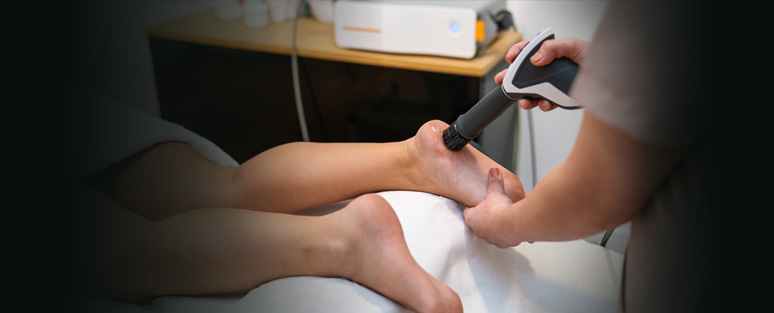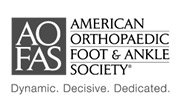Achilles tendon pain may arise from Achilles tendonitis, weakness of the calf, hip and other lower extremity muscles or abnormal mechanics of the body during walking and especially during running or sports. Full Achilles tendon tears require immediate medical attention and will not be discussed in today’s blog. If you’ve injured your achillles tendon traumatically, then please seek medical attention.
Today’s BLOG will focus on 5 easy steps you can take to manage Achilles tendon pain.
If you have not been evaluated by a physical therapist for your Achilles tendon pain, please do so. Refer to my BLOG on Find a Good PT to access services in your area.
The Achilles tendon attaches the muscles of the calf to the heel bone. It is long, fibrous and narrows as it descends as noted below. When we walk, the Achilles tendon is used when we push off (or point the toe) and also controls the foot as it hits the ground. Injury and pain in the Achilles tendon can occur with muscle imbalance in strength and flexibility, wear and tear, sports and poor mechanics of the hip, knee, foot and ankle. Circulation to the tendon is not as rich as it is to the muscle and scarring frequently occurs on the front and sides of the tendon.
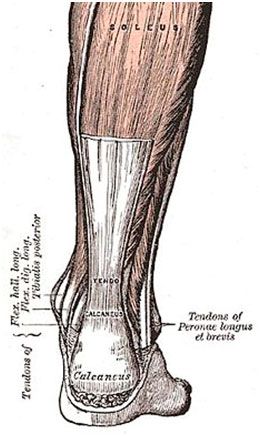
Below I have listed the most common treatments we prescribe during physical therapy to relive Achilles tendon pain. What works for you is related to your particular diagnosis so please see a PT for your Achilles tendon pain before you try any of these treatments.
- Eccentric strengthening exercise: Often through wear and tear and abnormal mechanics, Achilles tendon pain eventually leads to a thinner, weaker muscle tendon unit. Eccentric exercises or exercises that strengthen muscles as they lengthen are very effective in reducing Achilles tendon pain. Stand on the edge of a step with your heel hanging off. Rise up onto your toes and slowly lower. Repeat up to 100 repetitions daily until your Achilles tendon pain improves.
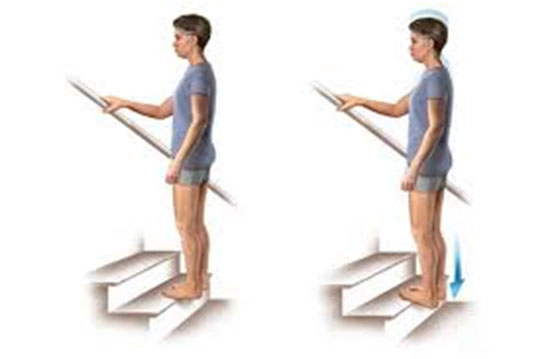
- Stretching Exercises:
The Achilles tendon can become scarred down and very tight. Stretching your Achilles tendon as pictured below allows the tendon to improve flexibility and reduces scarring. Perform when after the tendon is warm keeping your toes pointed straight forward. Hold 30-60 seconds, 3-5 times daily and always with exercise.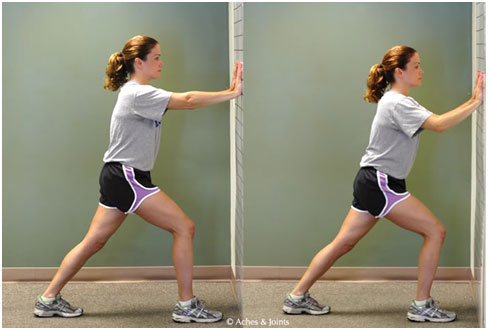
- Deep Transverse Friction Massage:
As I stated above, with most chronic Achilles tendon injuries, scars form along the front and sides of the tendon. Scarring adheres the tendon to adjacent soft tissue and tendon sheaths. Scars must be removed in order for the Achilles tendon to heal and for the Achilles tendon pain to resolve. In physical therapy, we use deep transverse massage to reduce the scar and create local inflammation. The local inflammation restarts the healing process for chronic achillles tendon tears. When seeking care for your Achilles tendon injury, inquire if this treatment or Graston/a-stym is available. In physical therapy, we typically perform deep rasnverse friction massage 2-3 times weekly and have our clients perform it 1-2 times weekly at home when able. Depending upon the chornicity of the injury and size of the scar, these treatments may last 3-6 weeks. Once the scar is reduced, physical therapy treatments for Achilles tendon pain are designed to remodel the Achilles tendon tissue encouraging cell proliferation, and growth. - Improve lower body movement patterns:
Often, weakness of the hip, core, gluteals, hamstrings or foot intrinsic create imbalance that causing overuse of the Achilles tendon. Diagnosis and treatment of these weakness patterns are essential for full recovery from Achilles tendon injury. In addition, stiffness patterns in the lower back through the foot may be causal in the overuse injuries commonly found with chronic Achilles tendon pain. - Change Footwear
Sometimes the Achilles tendon is painful from overuse with walking and running. You may need to get more supportive footwear or a different kind of athletic shoe. Many clients ask us what type of shoe to get and there literally is not a “one size fits all” answer. Depending upon how you are built and how you walk or run, you may want a shoe with lots of arch support or little, a large heel angle or none. The best advice I can give you is purchase athletic shoes a half to a full size larger than your actual foot size to accommodate for the normal amount of swelling that occurs with activity. Secondly, make sure the toe box is adequate to fit your whole foot without rubbing the sides. Third, if you have a bunion wear a silicon toe spacer between the second and first toe.
Achilles tendon pain and injuries may take up to 6-9 months to heal depending on the chronicity, health of the tissue, your diligence with exercising and other activity related factors. The tendon itself heals very slowly and you must be patient. As with any injury or pain, please consult a physical therapist to get a thorough evaluation. In the Portland area we can be reached at 503-295-2585 or info@lifesworkpt.com. Outside of the Portland area, consult apta.org to find a local physical therapist.
Best of Luck!
Sandra






